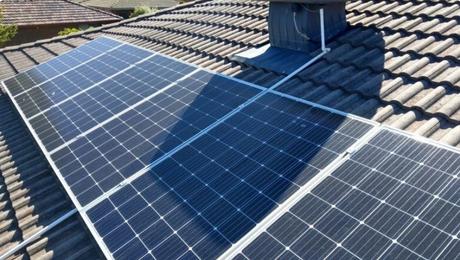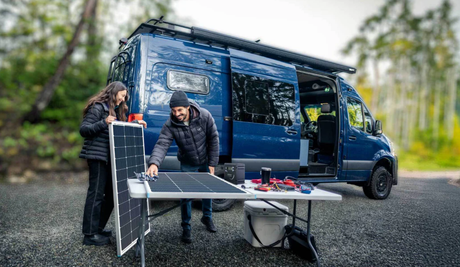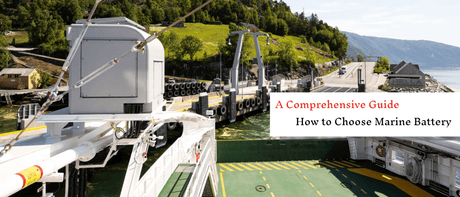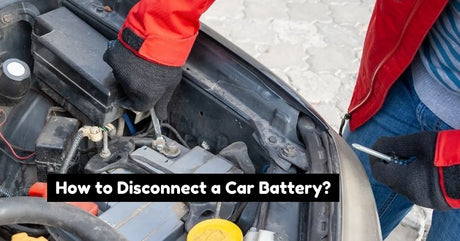There's no other way to explore Canada's wonderful outdoors than through caravanning, 4WDing, or sightseeing. You'll have to have a reliable battery pack to charge your electronics when parked. The battery will power your refrigerator, lights, power banks, and music systems, among other things. As a result, regardless of how much energy these gadgets consume, the vehicle's primary battery will stay untouched, prepared to start the engine when you want to move.
However, your vehicle's alternator will strain to effectively charge or maintain both batteries due to different charging properties between various types of batteries at varying degrees of charge. You can solve this problem by using a DC-DC battery charger.
What is a DC to DC Battery Charger?
They're smart chargers that run on 12-volts, to put it simply. They accomplish this by converting the alternator's energy into an output current that's perfect for charging or maintaining your backup battery. Because alternators aren't specialized chargers, they're not very adept at it.
Their primary function is to run the vehicle's electrical circuit; their secondary role is to recharge the primary battery following a start-up. When charging a practically full primary battery and a drained battery simultaneously, alternators don't operate effectively. A DC-DC charger will prolong the life and performance of your auxiliary backup battery by resolving these charging concerns.
What does a DC to DC battery charger do?
Fundamentally, DC-DC chargers take the alternator's power and transform it to a greater amperage rate. The battery charger will charge the backup battery at whichever voltage the backup battery can handle. This can be approximately 50 amps based on the charger's capacity. This enables the backup battery's charge to be replenished quickly.
High-quality DC-DC chargers are three-stage chargers. This implies that various levels are employed while the battery charges.
- Stage 1: Boost- this offers the greatest voltage possible when charging a depleted battery.
- Stage 2: Absorption – This is a continuous charge that is kept up until the battery pack current requirement drops below 4 amps.
- Stage 3: Float- This is a lesser charge that keeps the battery at roughly 13.3 volts, almost fully charged.
A DC-DC charger excels when the backup battery pack is located far from the alternator. Backup batteries are also frequently installed in battery boxes.
The voltage loss is minimized when heavy gauge wires are used, and placing the charger near the backup battery as feasible guarantees that the optimal voltage is given.
It also helps to have the DC-DC charger adjacent to the primary energy demand.
Why do I need a DC to DC battery charger?
Briefly, irrespective of the alternator model in your car, your DC-DC charger will fill your backup battery quicker, to a much higher level, and securely.
A DC-DC charger is essential for optimal charging maintenance if you drive a contemporary car with a low-wattage alternator.
Using a DC-DC charger instead of a standard parallel wired twin battery system will dramatically improve the supplementary battery charge if you have an older car with a fixed wattage alternator. This is because an alternator never was intended to serve as a dedicated battery charger, particularly in the case of a dual battery system.
Because there was frequent space in the engine area to place an extra battery, conventional parallel wiring of a backup battery was sometimes more straightforward on early automobiles. The backup battery has to be near the primary starter battery for this design to operate.
Since current engine compartments are so congested, finding an auxiliary battery may be difficult, resulting in a smaller battery to make it fit. A charger that can be placed anywhere, on the other hand, gives you extra battery positioning possibilities.
A decent charger will adapt to fit the battery type you have, be it Lead Acid or Lithium, thanks to the algorithms in the charger. If you are thinking about getting a lithium battery, you must use a DC-DC charger.
The smart charging phases will further extend the battery's lifespan and efficiency, whether or not you are coupling it with accessories.
Dc to DC chargers or isolators
A battery isolator will not operate appropriately in automobiles with a computer-operated alternator. These automobiles have a charging system that prioritizes fuel efficiency and pollution, frequently lowering the charging current below the isolator's stop voltage. This implies that the isolator will believe the car is switched off when it isn't, and it will segregate the two batteries, preventing the backup battery from charging.
If your automobile has a computer-operated alternator, you should consider adding a DC-DC charger. As a general rule, if your automobile is newer than 2015, it will almost certainly have a computer-operated alternator.
What is an on-board DC to DC charger?
Auxiliary batteries were being charged from the alternator before smart alternators became common. Alternators utilized isolators to redirect surplus electrical current to charge extra batteries. However, with the advancement of more robust electrical generators, there is a little additional charge, making it practically hard to charge your auxiliary battery completely.
Unlike a portable device, an on-board charger is permanently installed in the car or boat. You may find the following on-board chargers in the category of on-board chargers:
- Chargers that work with AC and DC power are powered by a 115V or 220V source and hooked into an outlet in a motorhome storage area while the boat is docked.
- Fixed DC-DC chargers on the car or boat
How do you hook up a DC to DC charger?
Acquiring a charger and a battery is only the first step in installing a battery system in your caravan or camping trailer. Your system must be connected in the safest possible manner to deliver the best performance and lifespan.
Always reference the owner's handbook for proper installation, as with any electrical wiring. Renogy, Canada offers detailed DC-DC charger wiring schematics to help experts and DIY installers.
Fundamental Battery wiring diagrams are as follows:
- Connecting the starter battery to the charger situated as near as possible to the starting battery
- Charger with an inbuilt breaker for the home battery
- Charger to solar panel connection
Wiring schematics frequently prompts several queries, such as:
- What cable size do I require?
- What fuse size do I require?
- How long do I need the cable to be?
With Renogy Canada, you will get detailed installation schematics particular to your charger installation needs, be it a car or solar charger installation guide, to make it easy for you. The guidelines for installation include the proper length of cable, the appropriate size fuse, and the correct size fittings for attaching the charger to the car and home batteries.
What size DC to DC battery charger do I need?
If you're considering using a DC-DC charger, keep in mind the amps you'll need. Chargers for dual batteries generally vary from 6 to 40 amps.
A 25-amp battery charger is suitable for battery bank capacities of 75-200AH, while a 40-amp battery charger is suitable for greater capacity demands. What is the significance of this?
Excess flow of current into a battery can have various consequences, the most serious of which is reduced battery performance and lifespan. That is why it is critical first to choose which accessories you want to use while camping, then determine the battery capacity necessary, and finally select the appropriate battery charger depending on those requirements.
What Other Factors Should You Look for When Choosing a DC-DC Battery?
There are several other factors to look for when choosing a DC-DC battery, including:
- Type of battery
- Install location
Install Location
It's also essential to think about where you'll put the charger. If you're going to use the charger beneath the hood, make sure it's waterproof, resistant to heat, and dustproof. It is recommended to verify that the DC-DC Charger is acceptable for placement in cabinets, drawers, or confined locations and that it has enough airflow or cooling mechanism to manage the compartment's temperature.
Type of Battery
The DC-DC Charger must be interoperable with the battery model being charged. Not all battery chargers on the marketplace, for instance, are lithium compatible.
What Features Can I Look for in a DC-DC Charger?
So, what distinguishes one DC-DC charger from another? In many ways, it is dependent on your requirements. However, there are some crucial aspects to consider while purchasing a DC-DC charger. For starters, a good charger ought to be adaptable. It makes a tremendous impact based on what you're attempting to accomplish. Not just that.
If you don't need it right now, you should seek solar compatibility. Year after year, solar panels get more affordable. It may not be long until the cost of installing a tiny solar array is so low that we all do it. Solar panels can keep your batteries charged when your automobile isn't operating.
The amount of energy required for charging is also a factor to consider.
The amp-hour capacity of different vehicle batteries varies greatly, such as deep cycle boat batteries, with even more significant capacity variations. A charger that is too feeble will not fully charge such types of batteries.
On the other hand, an overly powerful charger might destroy cells unexpectedly. Heightened wear and tear will significantly shorten your battery's life. To put it another way, a powerful charger isn't always better. It is best to match a charger to your battery to receive the most remarkable results.
Many chargers will alter their power based on the demands of your battery. Many people can adapt to different battery types, like lithium-ion. If your battery charger is more adaptable, you'll have very little to fret about compatibility.
Similarly, you'll want a battery charger that's designed just for your needs. Some chargers are built for intense use, such as in daily-drive automobiles. But you could find that a trickle charge is more valuable than a full charge.
Over the cold season, a suitable DC to DC charger can keep a battery charged. You may also use it to maintain a historic automobile battery charged between events. Because they don't have to withstand as much stress, these chargers are usually smaller.
Your charger may have to operate at extremely low or extremely high temperatures depending on your circumstances. While you're out shopping, keep these evaluations in mind. High heat may be a problem for automobile chargers in even temperate locations. Even on a moderate day, the area behind your hood might become quite heated.
This is also subject to change according to how you drive. There'll be less ventilation, and your engine bay will be heated whether you're driving in the city or off-roading. If you spend considerable time on the road, the additional air circulation will make the cabin correspondingly colder.
Finally, a reliable DC to DC charger should include lights and indications that are simple to read. This may appear to be an utterly aesthetic issue, but it isn't. The last point you need to be concerned about is determining whether the charger is connected correctly. You should be able to check the status of the defect at a glance as well.
Some chargers have a smartphone app that makes this process even more accessible. This helps to verify the status of your charger without having to open the hood. The most important aspect is that it's simple to comprehend what's happening throughout the installation.
Conclusion
Investing in a battery charger might help you prolong your battery's lifespan. Battery chargers safeguard your battery by keeping a stable charge, therefore, preventing damage, and they may also repair damage caused by severe discharges and regular use.
Several factors can harm a battery over which you have no control. Intense temperatures cause batteries to perform at high-performance levels, allowing them to discharge more energy. Due to this, batteries in hotter areas have a shorter life duration.
If you reside in a region where certain environmental conditions are prevalent, a battery charger may be even more critical to your battery's longevity. Battery chargers are a terrific acquisition that saves you money in the long run.
Although all automobile batteries ultimately fail, it does not have to happen as rapidly as some people assume. A car battery may live for ten years or more if properly maintained and kept in the appropriate circumstances. We recommend going to Renogy, Canada, for the best battery chargers if you have a limited battery charger.










